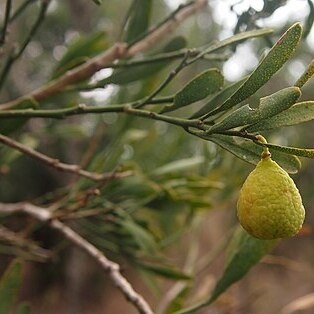A medium sized shrub or small tree. It often has several stems and grows up to 2-3 m high. It can be up to 12 m high and 1-3 m across. The bark is brown and cracked. The new shoots are angular. The stems are spiny. The leaves are 1-5 cm long by 0.2-0.4 cm wide. They are narrow and spoon shaped. The leaves have a blue-grey colour. The flowers are 1-1.3 cm across. They are white or green and have a sweet scent. The fruit is round to oval and about 2 cm across. The skin of the fruit is light yellow green. It contains large oil glands. The fruit are often seedless. The seeds have furrows along them.


